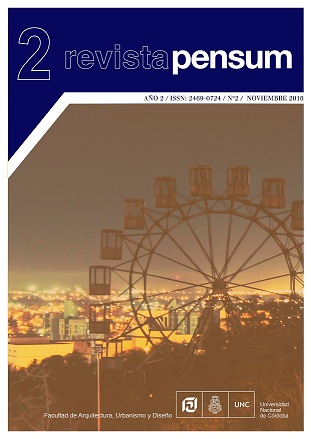from VIRTUAL tO TANGIBLE: TRANSFORMAtionS from morphologic configuration to digital consTRUCtIoN
DOI:
https://doi.org/10.59047/2469.0724.v2.n2.16519Keywords:
Morphology, Design process, Digital manufacturingAbstract
In the theory of architecture, since the mid-nineteenth century there are two categories of formal configuration for the design and construction: sternotomy and tectonics. Both they have compositional qualities with clearly defined and differentiable procedural and conceptual logic. Technological advancement linked to computer has expanded the territories of production tools and digital fabrication techniques. However tectonics and sternotomy remain in effect as mindsets and operate the project. This article summarizes the conceptual principles of digital manufacturing systems and avant-garde case study of the architectural and artistic context are analyzed to observe phenomena that occur in the processes of design incorporating new information technologies, from conception to the finished work. this paper derives from the author's doctoral thesisReferences
Iwamoto, L. (2009). Digital fabrications: architectural and material techniques. New York: Architecture Briefs.
Kolarevic, B. (2001) Digital Fabrication: Manufacturing Architecture in the Information Age. En Proceedings of the
twenty first annual conference of the Association for Computer-Aided Design in Architecture, 2001 (pp. 268-277).
New York: ACADIA.
Krauel, J. (2010). Arquitectura Digital: Innovación y diseño. Barcelona: Links.
Naselli, C. A. (2001). El proceso de diseño como como concepto instrumental. En N. Goytía (Ed.), Cuando la idea se construye (pp. 28-32). Córdoba: Screen.
Pimentel, D. (2004). Superconectados. En A. Montagú, D. Pimentel, M. Groisman (Aus.) Cultura digital: comunicación y sociedad (pp. 25-96). Buenos Aires: Paidós.
Semper, G. (1860-1863). Der stil in den technischen und tektonischen künsten, oder, praktische aesthetic. Frankfurt: Verlag für Kunst & Wissenschaft (Vol. 1, 1860); Minich: F. Bruckman (Vol. 2, 1863).
Downloads
Published
Issue
Section
License
Authors who publish in this journal agree to the following terms:
a. Authors retain copyright and guarantee to the journal the right to be the first publication of the work as well as licensed under a Creative Commons Attribution-ShareAlike 4 license.
b. Authors may separately establish additional agreements for non-exclusive distribution of the version of the work published in the journal (e.g., placing it in an institutional repository or publishing it in a book), with an acknowledgement of its initial publication in this journal.
c. Authors are permitted and encouraged to disseminate their work electronically (e.g., in institutional repositories or on their own website) before and during the submission process, as this may result in productive exchanges, as well as earlier and greater citation of published work (See The Effect of Open Access).
d. 4.0 International Creative Commons Attribution-ShareAlike 4.0 License.












